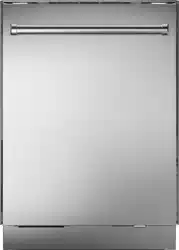Loading ...
Loading ...
Loading ...

ActionPossible causesProblem
Check that the dishes are not
blocking the spray arms.
The spray arms do not rotate.The dishes are not clean.
Clean the spray arms. See the
chapter Care and maintenance
instructions.
Spray arm holes or bearings
blocked.
Select a program with a high
temperature to dissolve grease
on heavily soiled dishes, such
as Intensive.
Unsuitable dishwashing
program.
Dose according to water
hardness. Far too much or far
too little detergent can result in
poor dishwashing results.
Incorrect detergent dosage.
Avoid large packages.Detergent is too old. Detergent
is a perishable product.
Do not cover porcelain with
large bowls or the like. Avoid
placing very tall glasses in the
corners of the baskets. See the
chapter Loading the
dishwasher.
Dishes loaded incorrectly.
Load the dishes securely.Glasses and cups have toppled
over during the program.
Clean the coarse and fine filters.The filters are clogged.
Check that the filters are fitted
correctly. See the chapter Care
and maintenance instructions.
The filters are not fitted correctly.
Check that the yellow drain
pump stop (on the right in the
bottom drain) is in place. See
the chapter Care and
maintenance instructions.
Drain pump stop missing.
Rinse off these types of food if
not starting the dishwasher
immediately. Use the Rinse and
hold program.
Some types of food, such as
mustard, mayonnaise, lemon,
vinegar, salt, and dressings, can
cause spots on stainless steel if
left for too long.
Spots on stainless steel or silver.
In order to avoid marks and
tarnishing, separate dishes
made from different metals,
such as silver, stainless steel,
and aluminum.
All stainless steel can cause
spots on silver if they come into
contact during dishwashing.
Aluminum can also cause spots
on dishes.
32
Troubleshooting
Loading ...
Loading ...
Loading ...
